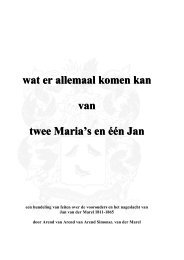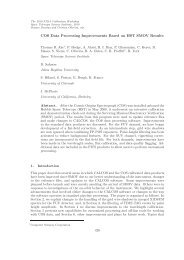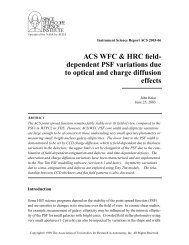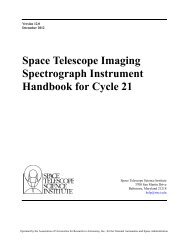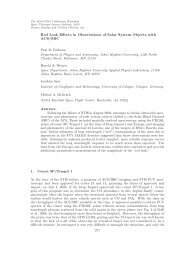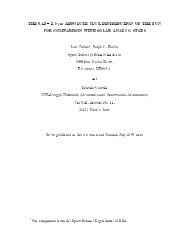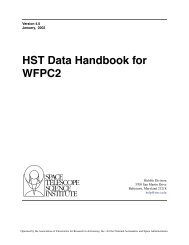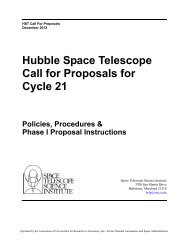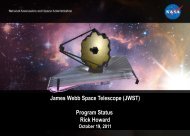STScI Annual Report 2002: A Living Mission
STScI Annual Report 2002: A Living Mission
STScI Annual Report 2002: A Living Mission
Create successful ePaper yourself
Turn your PDF publications into a flip-book with our unique Google optimized e-Paper software.
52 achievements<br />
We completed a major redesign of the JWST exhibit for outreach to the professional science community.<br />
The redesign focuses on the basic science goals of the mission. It uses backlit boxes and video materials<br />
showcasing the latest news.<br />
We began work with the National Park Service to produce a resource CD for park rangers who give<br />
interpretive night-sky talks.<br />
Origins Education Forum<br />
OPO is the home to the Origins Education Forum, a part of the NASA Office of Space Science Education<br />
and Public Outreach support network. We help missions communicate and coordinate outreach activities<br />
with each other. Also, we provide unique services to enhance the value of their outreach efforts.<br />
We organize monthly telecons, splinter meetings at astronomical meetings, and an annual outreach<br />
retreat for the Origins missions, which are scattered around the country. We capture and disseminate lessons<br />
learned by missions about developing and disseminating educational products. We also provide programand<br />
product-evaluation services. We coordinate exhibits, staffing, schedule, and material dissemination<br />
at numerous conferences each year.<br />
In <strong>2002</strong>, the Origins Education Forum provided evaluation services to the Space Infrared Telescope<br />
Facility, Space Interferometry <strong>Mission</strong>, NASA Astrobiology Institute, and Stratospheric Observatory for Infrared<br />
Astronomy. We held ‘tag-up’ meetings in conjunction with each American Astronomical Society meeting.<br />
We released a new version of the NASA Space Science Education Resource Directory (SSERD),<br />
improving usability for the missions entering products into the directory.<br />
We initiated developing a new strategic plan for the Origins Education Forum. We began with in-depth<br />
interviews with our stakeholders to develop a consensus on the role and charter of the Forum.<br />
Goal 5: Facilitate technology transfer<br />
We will continue to facilitate the transfer of our technical innovations to other fields of research and<br />
to the private sector.<br />
The astronomical community recognizes our software products for operating Hubble for their effectiveness,<br />
efficiency, and quality. Several other NASA space astronomy missions have adopted our planning<br />
and scheduling software and our distributed data processing pipeline software. Such reuse of our software<br />
has permitted those missions to become operational with lower cost and lower risk, and it has<br />
afforded the community of astronomers the benefits of multiple missions performing efficiently.<br />
While our first commitment is to the advancement of astronomical science, as called for in the<br />
charter of AURA, we know there are wider applications for our software systems than their originally<br />
designed purpose. Already, commercial industry has two of our systems—our fully distributed data<br />
processing pipeline system and our multi-mission planning and scheduling system—for help in running<br />
their enterprises. We seek to make our software products available to this wider spectrum of industry.<br />
This year, we provided greater focus to technology transfer by vesting our Community <strong>Mission</strong>s<br />
Office with responsibility to coordinate our response to industry enquiries and to manage any resulting<br />
activity to provide products and services. This office provides a centralized, unified approach for dealing<br />
with potential clients in a professional and helpful way.<br />
We also made our products more visible on the website of our Engineering and Software Services<br />
Division (ESS). There, interested parties—both within the scientific community and in other industries—<br />
can find clear and up-to-date descriptions of the range of products we have developed and use today on<br />
Hubble. Because our systems were designed to deal with changing suites of science instruments on<br />
Hubble, and to accommodate different generations of computer hardware at the Institute, their built-in<br />
flexibility and resilience makes them easily adaptable to other uses.<br />
To support our users around the world, ESS has initiated ‘help-desk’ type support for our software<br />
systems currently employed on other missions and in commercial industry. Aimed at responding to<br />
problems, this support is also effective answering community enquiries about the technical characteristics<br />
of these products. With such information available, we believe the commercial world will find our<br />
systems attractive and useful—benefiting both themselves and the science community through the<br />
continued evolution of these products.



